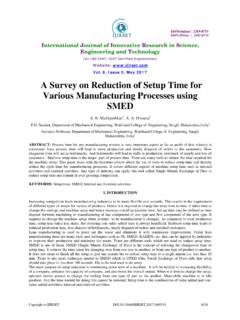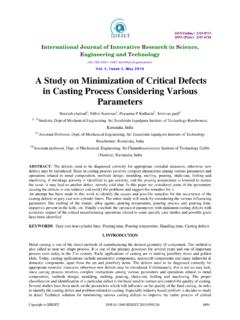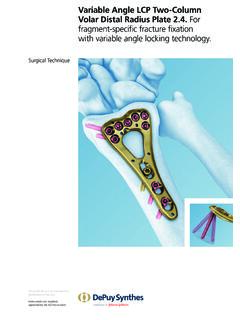Transcription of A STUDY ON GROUND IMPROVEMENT USING STONE …
1 ISSN: 2319-8753 International Journal of Innovative Research in Science, Engineering and Technology (An ISO 3297: 2007 Certified Organization) Vol. 2, Issue 11, November 2013 Copyright to IJIRSET 6451 A STUDY ON GROUND IMPROVEMENT USING STONE COLUMN TECHNIQUE Karun Mani1, Student, Dept, of Civil Engineering, of Engineering, Ernakulam, Kerala, India 1 Student, Applied Mechanics & Hydraulics, NIT-K, Surathkal, Karnataka, India 2 Abstract.
2 GROUND IMPROVEMENT is an important requirement in today s construction industry as land reclamation is becoming increasingly popular. The STONE column technique is a very efficient method of improving the strength parameters of soil like bearing capacity and reducing consolidation settlement. It offers a much economical and sustainable alternative to piling and deep foundation solutions. GROUND IMPROVEMENT when implemented through STONE column technique aids in a much stable solution to construction in weak cohesive soils.
3 The paper is an attempt to discuss in detail about this technique to improve soil stability, including it s salient features, design parameters, major functions and drawbacks. Keywords: Vibrofloat, Reclamation, Stabilization, Soil I. INTRODUCTION India has large coastline exceeding 6000kms. In view of the developments on coastal areas in the recent past, large number of ports and industries are being built. In addition, the availability of land for the development of commercial, housing, industrial and transportation, infrastructure etc.
4 Are scarce particularly in urban areas. This necessitated the use of land, which has weak strata, wherein the geotechnical engineers are challenged by presence of different problematic soils with varied engineering characteristics. Many of these areas are covered with thick soft marine clay deposit, with very low shear strength and high compressibility. Out of several techniques available for improving the weak strata, STONE columns have been used to a large extend for several applications.
5 The design of STONE column is still empirical, based on past experience and needs field trials before execution [4]. STONE columns are continuing to gain popularity today due to the considerable savings to cost and programme schedule that it can offer over conventional piling solutions in many circumstances [2] Fig. 1 Cross section of STONE column Fig. 2 Mechanism of load transfer ISSN: 2319-8753 International Journal of Innovative Research in Science, Engineering and Technology (An ISO 3297: 2007 Certified Organization) Vol.
6 2, Issue 11, November 2013 Copyright to IJIRSET 6452 II. INFLUENCING FACTORS A. Soil Subsurface soils whose undrained shear strength range from 7 to 50 kPa or loose sandy soils including silty or clayey sands represent a potential class of soils requiring IMPROVEMENT by STONE columns . Subsurface conditions for which STONE columns are in general not suited include sensitive clays and silts (sensitivity > 4) which lose strength when vibrated and also where suitable bearing strata for resting the toe of the column is not available under the weak strata.
7 B. Treatment depth The treatment depth with STONE column for a given soil profile should be so determined that the STONE columns extend through the most significant compressible strata that contribute to the settlement of the foundation. Average depth of STONE column accomplished in India may be around 15m, although with equipment modification, higher depths beyond 20 m are now becoming widespread. C. Area of treatment STONE columns work most effectively when used for large area stabilization of the soil mass.
8 Their application in small groups beneath building foundations is limited and is not being used. Thus, large loaded areas which apply uniform loading on foundation soils, such as beneath embankments, tank farms and fills represent a major area of application. III. PRINCIPLE The stabilization of soils by displacing the soil radially, with the help of a deep vibrator, refilling the resulting space with granular material and compacting the same with the vibrator is called vibrostone columns or simply STONE columns .
9 In other words, STONE columns are constructed where in the soft soil is strengthened by replacing a certain percentage of soil with aggregate. The aggregate column will act as a drainage channel to release the excess pore water present in the subsoil. The degree of IMPROVEMENT of soft soils by STONE columns is because of the densification of the surrounding soft soil during the installation of STONE column itself and the subsequent consolidation process occurring in soft soil before the final loading of improved soil.
10 IV. INSTALLATION TECHNIQUES A. Non Displacement Method The process of installation where soil is taken out during boring is called non displacement type of installation. 1) Bored Rammed System: The bored rammed STONE columns are used in cohesive soils. In this technique, a casing pipe is used to remove the cohesive soil protecting the sides of the bore, thus minimizing disturbance to the surrounding soil. The stones are laid into the bore and rammed to a larger diameter as the casing pipe is withdrawn.














